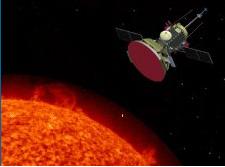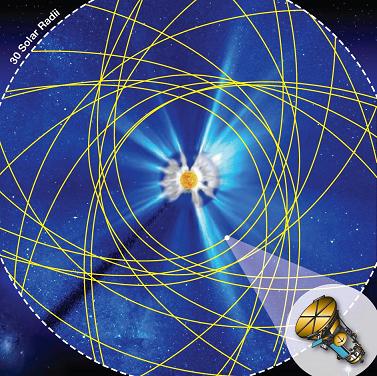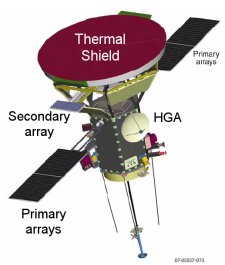A spacecraft that will be rigid enough to get closer and closer to the sun each time will be able to provide new insights into phenomena on the planet that affect the planets, including the Earth * and as a scientific bonus the spacecraft will also approach Venus several times with much more equipment than the previous spacecrafts that explored the planet

For over 400 years, scientists have been studying the sun from afar, and now NASA has decided to go there. "We are going to study a living, breathing planet for the first time" says the project's chief scientist Lika Gudhakurta from NASA headquarters. "This is an area of the solar system that has not yet been researched and the opportunities for discoveries there are many.
The name of the mission - Solar Probe Plus, a spacecraft designed to be resistant to heat so that it can enter deep into the sun's atmosphere where it can sample particles from the solar wind and study the phenomenon of magnetism firsthand. The launch is not expected before 2015. By the end of the mission, seven years later, scientists believe that Solar Probe Plus will solve the great mysteries of astrophysics and make many discoveries along the way.
The spacecraft is currently still in the first and even preliminary planning stages at NASA headquarters, Gohdakurta says. "There is still a lot of work ahead of us, but it is very exciting."
The Applied Physics Laboratory (APL) at Johns Hopkins University will design and build the spacecraft for NASA. APL has experience in sending spacecraft to the Sun, the Mercury Messenger spacecraft already completed its first approach flight around the planet Mercury in January 2008 and many of the thermal protection technologies used by the Messenger will be able to augment the new spacecraft. The spacecraft, by the way, is called Solar Probe Plus because its design is based on a previous design from 2005 of a spacecraft known as Solar Probe.
At the closest point the distance of the spacecraft from the sun will be seven million kilometers or nine solar radii. The spacecraft's heat shield, which will be constructed of composite carbon, will have to withstand temperatures of over 1,400 degrees Celsius and will be able to survive radiation bursts at levels no previous spacecraft has experienced. Naturally, the spacecraft will be powered by solar energy. It will get its electricity from liquid-cooled solar collectors and will be able to hide behind the sun shield when the sun's radiation is too strong. At such distances the width of the sun is 23 times greater than in the earth's sky.

The two riddles facing the spacecraft planners and for which the mission is supposed to provide answers are what is the temperature in the Sun's corona, and how is the solar wind accelerated. As for the first puzzle - the corona: if we stick a thermometer on the surface of the sun, it will show about 6,000 degrees Celsius. Intuition says that as we move away the temperature will drop, but instead it rises. The outer atmosphere of the sun - the corona, is hotter than a million degrees Celsius, hundreds of meters than the surface of the sun below it. This high temperature is still a mystery over sixty years after it was measured.
As for the puzzle of the solar wind - the sun emits charged particles at a speed of a million km/h and more, crossing the solar system. The planets, comets, asteroids - everyone feels them. Strangely, there is no sign of the solar wind near the surface of the Sun, but near the planets it is a real storm. Somewhere in between, an unknown factor gives the solar wind its enormous speed. The question is what is that factor.
To resolve the issue, Soler Prove Plus will actually be included in the petition, Gohdakurta says. The spacecraft's payload will mainly include instruments designed to sense the spacecraft's immediate environment - a magnetometer, a plasma wave sensor, a dust sensor, a system for electron and ion analysis, penetrating instruments that will tell us everything we need to know to investigate the secret of the corona's heating and the acceleration of the solar wind," she said. .

The only remote sensing device that will be installed on Solar Probe Plus will be a camera that will photograph the hemisphere (H1 for short). This is a telescope that will take XNUMXD pictures of the Sun's corona similar to a medical tomographic scanner. The technique known as coronal tomography is a completely new approach to photographing the sun and it is possible only because the images are taken from a spacecraft moving close to the sun, passing through the coronal clouds and currents and photographing them while passing through them.
As mentioned, the intention is to launch the spacecraft in May 2015, so that it will approach the Sun towards the end of the 24th sunspot cycle, and finish towards the solar maximum - the middle (and peak) of the 25th cycle in 2022. This will allow the spacecraft to sample the corona and the solar wind at many stages of the solar cycle. A launch on this date will ensure a significant number of solar storms near the end of the mission. The researchers suspect that many of the dangerous particles produced by solar storms gain acceleration in the corona - exactly where the Solar Probe Plus spacecraft will pass. The spacecraft will be able to observe the process in action and show researchers how to predict energetic particle events that threaten the health and safety of astronauts in space.
Soler Prove Plus will make repeated penetrations into the corona. For this purpose, its operators will use the gravitational force of the planet Venus. The spacecraft will hop seven times between the Sun and Venus in six years to direct the spacecraft each time deeper and deeper into the Sun's atmosphere. And a bonus - even though Venus won't be the primary target of the mission, astronomers may learn new facts about the planet when the heavily equipped spacecraft passes by.
"Solar Probe Plus is an extraordinary mission of research, discoveries and deepening understanding" says Gohdakurta. "We are already looking forward to its activation."

7 תגובות
Moti,
Maybe before that it is better to find the golden heart-within the heart??
Greetings from my father, from eternity.
I heard a rumor that in cosmic eruptions there is gold for kilometers (all the gold found on earth is a cube of pure gold 20 m by 20 m) and in fact this is one of the common elements in the universe that came to us from the outside, if this is true watch the shuttle from the sun to Portnox and space exploration that it is doubtful that he left From the solar system, which by the way in a previous response I claimed that this is the research currently suitable for humanity in space.
By the way, what about electromagnetic storms that shut down every electrical device sometimes, even our lovely blue sphere.
Dawn
That way there is more time to explore in any depth.
I didn't understand why the spacecraft would make 7 separate passes back and forth between the Sun and Venus, why not just one pass to the maximum depth? What advantage does 7 separate passages have over a single entrance?
An interesting project, I hope that the spacecraft will really withstand the enormous temperature that prevails in the vicinity of the sun and its violent eruptions, the success of a mission of this magnitude will lead to a significant advance in the understanding of the system that controls our area.
But if you land on the sun, then only at night 😉